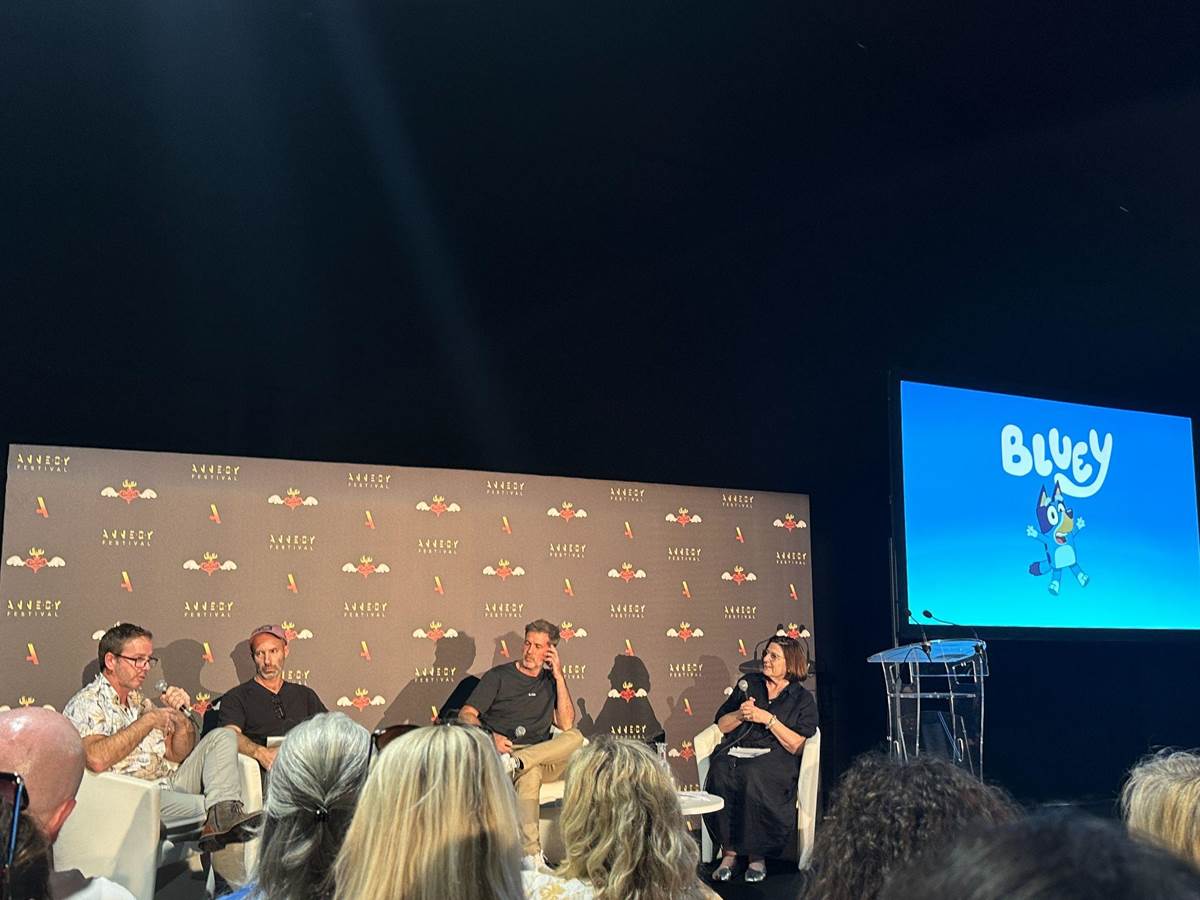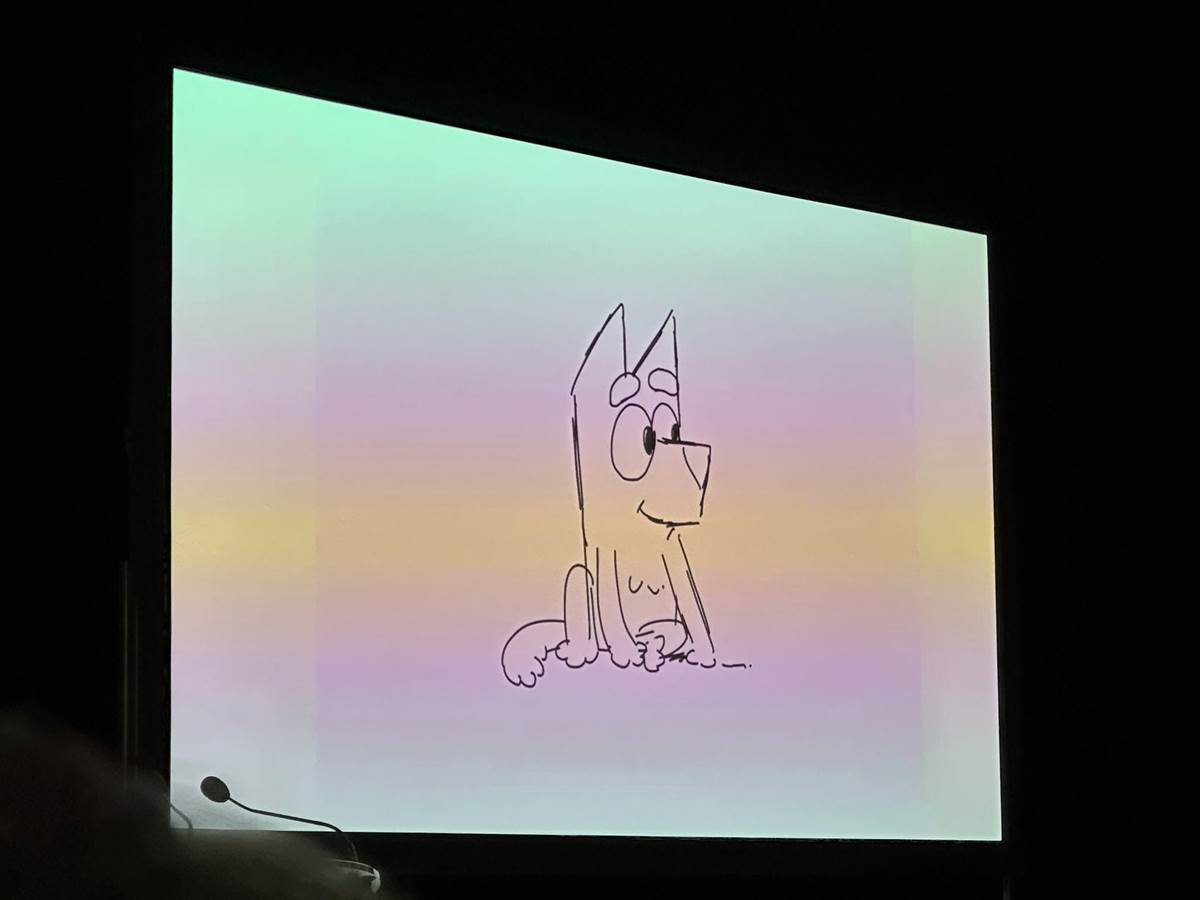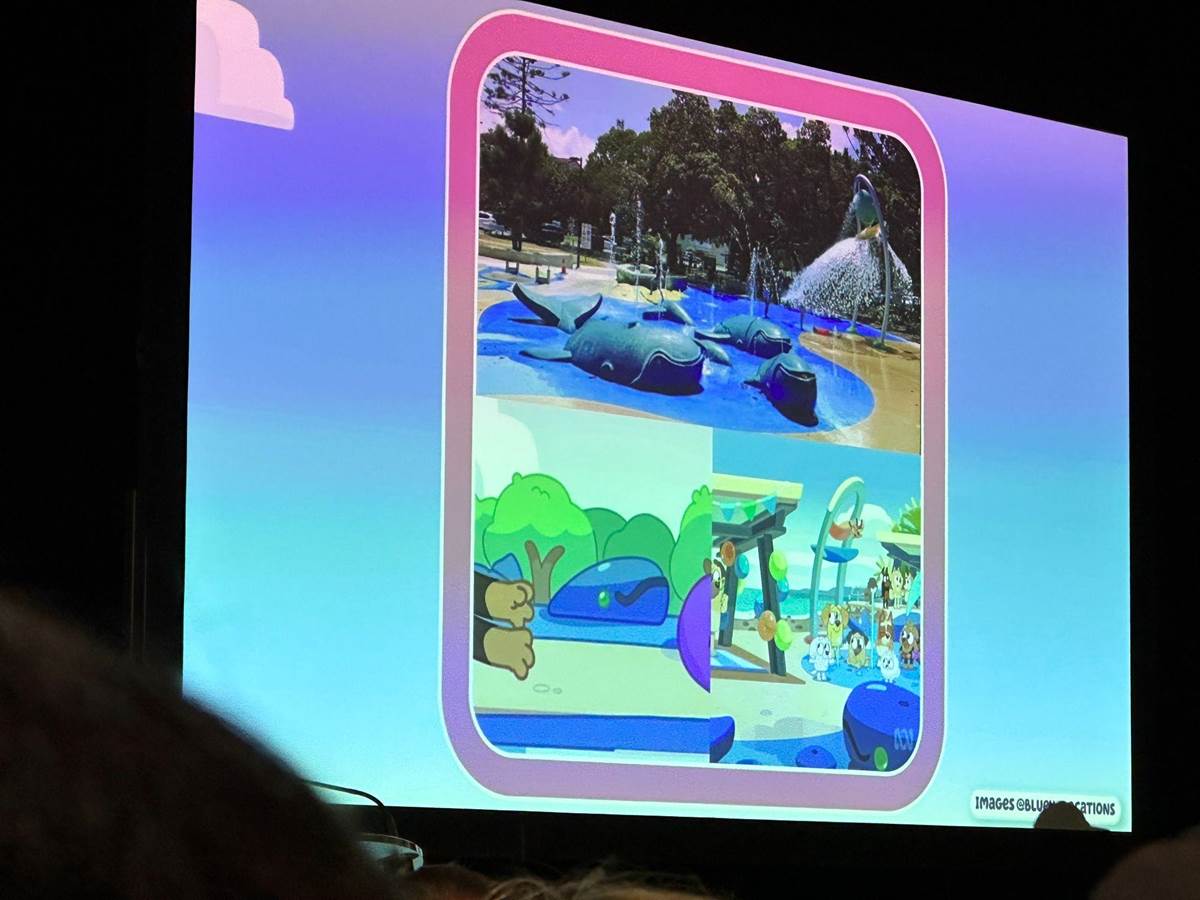Bluey may seem like an overnight sensation, but it’s actually the result of decades of hard work. That’s one of the big takeaways from an Annecy Festival panel from BBC Studios Kids & Family that shone a spotlight on everyone’s favorite blue heeler puppy, Bluey. Moderated by Henrietta Hurford-Jones (Creative Director of Indies for BBC Studios Kids & Family), the panel included series creator and writer Joe Brumm, series director Richard Jeffery, and animation director Mark Paterson.
Despite being made in Australia, Bluey’s origins go back twenty years to when Joe, Richard, and Mark first met while animating in London on series such as Charlie & Lola. Working alongside wonderful people in a great place and with many social gathering options after work, the trio discovered the perfect formula to create magic early on. It fostered a collaborative spirit and when it came time to part, they all found themselves yearning to go back to that type of experience. That’s actually part of the reason Bluey was made.
Joe and Mark returned to Australia, where they started their own production company, StudioJoho, in 2011. They were primarily making short-form content and pilots, intending to break even on costs so they could produce the highest quality animation possible and build their reputation. While they had fun, they missed the bonding experience they shared in London. But among their early concepts was a short about a family of blue heeler dogs. Joe had been looking for something uniquely Australian but didn’t want to retread overused animals like koalas and wombats. As a special treat, Annecy audiences got to see the one-minute short, which featured Bandit taking Bluey to a playground swingset, trying to multitask on his phone while pushing her, resulting in hilarious consequences.
That one-minute proof-of-concept encouraged them to begin developing things further, with the support of Henrietta from BBC Studios. That‘s when Joe and Mark called Richard, who had been in Kenya working on the BBC series Tinga Tinga Tales, which required him to oversee the creation and development of an animation studio where there hadn’t been one before. That experience would prove invaluable when he rejoined his pals in Australia, who needed to quickly expand to get Bluey off the ground.
Joe admittedly is not a character designer, but Mark helped refine the style the series. Being a cutout action show, characters needed to be geometric and simple. Worldbuilding began with the Heeler home, the main setting for the show. The simple shape language of the characters was extended to their world, with lines primarily horizontal and vertical rather than diagonal. Rounded rectangles became a hallmark of the show’s visual design. Created and set in Brisbane, a region famous for its colorful skies and landscapes, a distinct color palette became another true north for the series. The artists were inspired, creating Bluey’s version of the town around them.
Richard directed the 7-minute pilot ordered by the BBC, which was produced before all of the styles were finalized. Given the nature of the animation software, the animation could be updated with the final designs of the series later. Fans will know it now as an episode titled “The Weekend,” but Annecy attendees got to see clips from the original pilot, with a line swiping from left and right to compare each shot to the episode we know and love.
Like what Richard experienced in Kenya, the expanded Brisbane studio was full of young animators at the start of their careers. Character rigs were intentionally limited, which makes them highly efficient. The animation had to be great to match the beauty of the designs. Animators were given creative freedom to plus the scenes they were assigned and encouraged to take ownership of their work. The results has continued to surprise the three leaders of the show, who shared a reel of examples where animators went above and beyond with their assignments. Joe added that he loves to celebrate these moments, calling other animators over to desks to take a look at something amazing an animator has done. Joe believes this has been part of the secret to Bluey’s success, adding that kids can feel the scenes more when the animation is great.
Joe isn’t too surprised that Bluey has been a hit with kids and parents alike. As a parent, he understands the desire to want to be entertained alongside your child. That’s a tricky balance to strike, but he found that magic spot between childhood and adulthood. “Kids don’t get idiom,” Joe said about something he tries to avoid in the writing for Bluey. He leans more into physical and slapstick moments, such as Bluey and Bingo dressing as grannies. As a fun aside, the line “I slipped on my beans” came from “for real life.” Joe has a niece who was playing with toy food. She accidentally stepped on a plastic can of beans and fell, exclaiming the now famous line. A good example of the juxtaposition of adulthood and childhood is “Cafe,” in which Bluey instantly becomes best friends with a child on the playground and doesn’t understand why the two dads aren’t bonding just as quickly. Another is “Flat Pack,” which finds Bandit and Chili fighting with some build-at-home furniture while Bluey and Bingo imagine a fantasy world with the boxes the pieces came in. That episode also ends with a poignant message about the ravages of time.
Parenting has been the most emotional experience of Joe’s life. That’s why he and the creative team aren’t afraid to let powerful emotions sneak their way into the show. The end of “Grandad,” for example, has made many a parent cry. Mark talked about how his parents are still a rock in his life, so that moment when we see Chili with her dad and suddenly she’s a little girl again was heart-wrenching to create.
But Joe’s goal is not usually to evoke tears from his audience. He believes in optimism and wants each episode to make viewers feel good, no matter their age. That’s why the fan mail he receives is often so special. He paraphrased a particularly heartbreaking letter from a mother in Tasmania. One of her children passed away, and the other was high on the Autism spectrum. She told him that until Bluey entered their lives, there hadn’t been any laughter in the house for two years.
Speaking of laughter, it’s no coincidence that Bluey is all about playtime. Around the time the show was getting off the ground, Joe’s child started school in a highly academic program. He recalled seeing the life drained from his child’s eyes during that time. It didn’t take long for them to seek out another school, finding a play-based one that restored his child’s exuberance. Their teach actually inspired Bluey’s teacher Calypso in the series. Joe has seen firsthand the importance of social dramatic play, particularly between the ages of four and six when it can strengthen the imagination and help shed any lingering toddler ego.
As fathers, the team admitted that Bluey’s playtime has crept back into their homes. Richard, for example, says his kids have been wanting to play “Magic Statues” ever since that episode came out. Joe also shared one of the games his children loves, and how he kindly modified it out of consideration for parents who watch the show. At his house, what’s known as “Tickle Crabs” in the show is called “Pinchy” at home. Joe had to create a rule for his kids that they could only play it once a month for thirty seconds. So parents, know that when your kids try to play tickle crabs, it could’ve been worse. It could’ve been pinching.
“The show is the show because we had the support of BBC Studios, who knew what we were going for and just cleared the path for us,” Joe added. Another secret to Bluey’s success has been the voice of its title character, with Joe crediting Charlie & Lola for showing him the benefits of having real kids provide voices. When they have recording sessions with kids, he’s careful to get them at the right time of day, and also has lots of lollipops on hand.
https://twitter.com/laughing_place/status/1669346293213450248?s=20 While it’s no secret that Bluey is a smashing success, the hanging question by the end of the panel was whether Joe, Mark, and Richard achieved their goal of recreating the magical atmosphere they found on their first animation jobs in London. “The heart of the success is behind the scenes,
To close out the panel, Joe revealed that he first came to Annecy Festival as a student. Standing on the stage today was a full circle moment, the fulfillment of a wish he’s had for two decades. “We’re in a blessed industry,” he reminded the audience of future animators and artists. A few years ago, the group decided to submit an episode of Bluey to Annecy’s competition. A show can only do this once, and the episode they had planned on submitting was delayed, so they sent a different one. Mark considers it his opus, and said it’s an episode the entire crew is really proud of. And so, for the first time on a big screen with an audience who didn’t work on the show, we got to see the episode that could’ve been an Annecy Festival winner, “Sleepytime.”
Bluey streams on the U.S. on Disney+. Ten new episodes are set to begin streaming on July 10th.



